Eclipsing
Successful cloud prediction for the masses... err, for the students of Cornell.
METEOROLOGYJOURNEY


As the continental US got ready for the eclipse of the decade, it was an interesting time as a new meteorologist to be called upon to try and predict the best location for viewing. With every model run and prediction given, I hoped that everyone was learning how many components there are to Meteorology and how small movements in a large system can have major impacts on what ends up occurring... and that I would not take the blame for my miscalculations.
Here are the items that I had been looking at to prepare my friends and fellow clear sky chasers:
Cloud Cover
Cloud Thickness/Optical Depth
Skew-T
Regardless of the type of cloud, any film over light will reduce the full view. This concept had been the workaround goal from the beginning: clear skies. The biggest worry to me was the low-mid-level clouds. The cirrus clouds would be annoying, but in general, cirrus clouds have a lower optical depth than our puffy cumulus clouds or, even worse, in this case, lower-level stratus. The cirrus clouds wouldn't necessarily impede our ability to experience the full effect of the eclipse. That's when we generally look at the Skew-T graphs to see a stable atmosphere (in this case) hopefully, and where the dew point temperature meets/comes close to the environmental temperature, so we can see at what pressure/height level the clouds would potentially be forming and at what temperature. My fingers were definitely crossed for upper-layer clouds if I had to choose one.
I had been obsessively checking Pivotal Weather to get every single model possible (thank them for making the NWS blend available), and as we got closer to this incredible event, the models for cloud cover over much of the path of totality had gotten worse and worse. A week before the eclipse, the hope was to travel from Ithaca to Geneva and just chill. The clouds would be coming but wouldn't be there until an hour or two after the eclipse. The models were looking decent for a chance at clear skies but then came the horrible Saturday run.
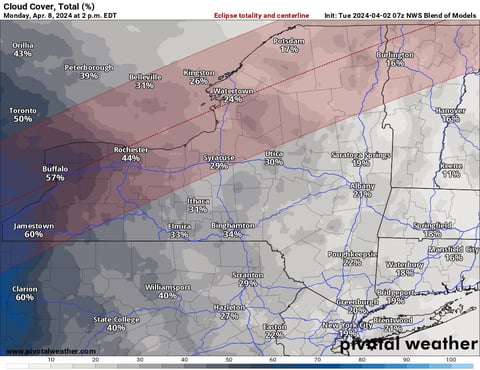


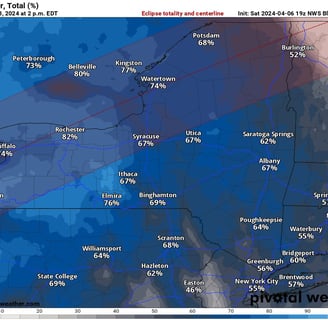
Boom, hope dashed, chances of clear skies minimal. There was no way we were going to be able to see through anything.
As we got closer to the time of the eclipse, there were little teases at potential clear-ish skies, but after transitioning to checking just the HRRR, there seemed to be a consistent hole appearing north of Utica. So when Monday morning rolled around, that was going to be our best bet within a 4-hour radius. I decided that our group should head to Beneveld and stop to do an assessment there.
NWS Blend of Models - Init: Tues 2024-04-02 07z
NWS Blend of Models - Init: Sat 2024-04-06 19z
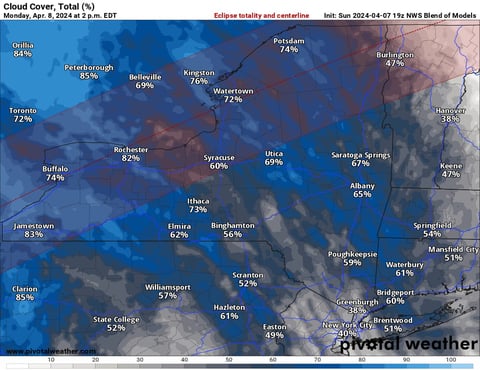

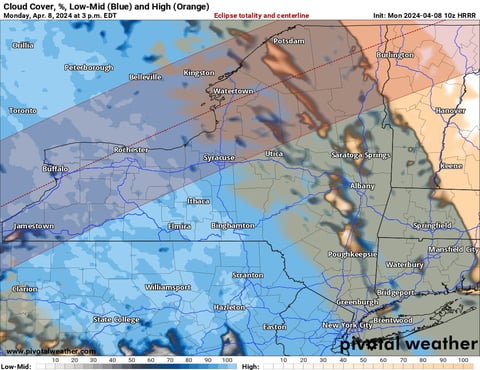

NWS Blend of Models - Init: Sun 2024-04-07 19z
HRRR - Init: Mon 2024-04-08 10z
The whole ride there was filled with me checking satellite imagery for real-time clouds and awaiting every HRRR run. There wasn't much to be done at that point, but I was concerned that the gap we were aiming for would either close or appear too south, and we would miss the totality mark. After reaching our first location and the gap thinning out but not totally disappearing, I pushed for our group to reassess at another stop in Old Forge. So we continued traveling, and along came the next model run... this was the screenshot I sent to some people who had not left Ithaca yet. There was a large gap appearing to the west, and our gap, which had been there so consistently, had disappeared.
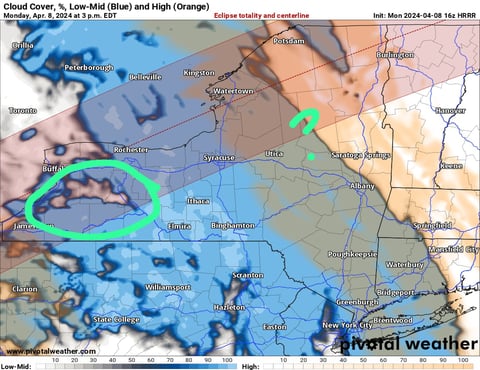

HRRR - Init: Mon 2024-04-08 16z
I truly could not believe it. I had led us on this not-so-wild goose chase when, if we had stayed put for a few more hours, we would have been able to see the eclipse without a cloud in the sky. "It is what it is" was definitely the theme for the next hour. Once we made it to Old Forge, we waited for the next model run to be released. Unfortunately, the time it was taking to load was going to put us too close to a make-it-or-break-it timing situation, so as a group, we decided it was worth it to go deeper into the Adirondacks. We all hopped into our cars, and the real chase was on. Taking a look at the satellite imagery, I could see that the hole that was in the model for our eastern front was still there in the clouds; we chose a location and rushed to it. There was barely a car on the road; everyone was already at their chosen viewing spots.
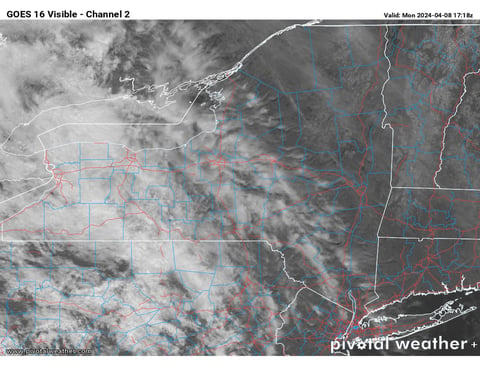

GOES 16: Mon 2024-04-08 17:18z
As we rushed to our third location (which, after a quick assessment, really moved us to our fourth), we got a call from some sophomore meteorology students who had gone after the western gap. They said that the saddest experience was happening: not only could they not see the eclipse, but worse, they were being rained on.
My group and one other vehicle made the mad dash to our final destination of Blue Mountain Lake, where there was a beautiful gap in the lower-level clouds and only very thin cirrus clouds. It was an incredible experience (albeit a bit creepy to me). We arrived about 8 minutes before totality. We watched from a dock as the moon crossed in front of the sun, and the corona appeared. It was sunrise for the 360 horizon around us. It was quiet. It got cold. We even took a minute of silence in the group. It was otherworldly.
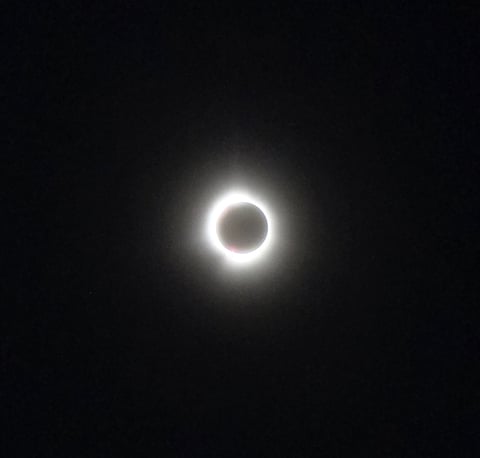

This turned out to be such an incredible experience using the knowledge gathered from my schooling; the journey really pushed the limits on predicting in live time for something we don't, as meteorologists, usually go for. Flipping the tables and hunting for the no-cloud areas was definitely a once-in-a-lifetime practice session. I wouldn't have missed it for the world.
